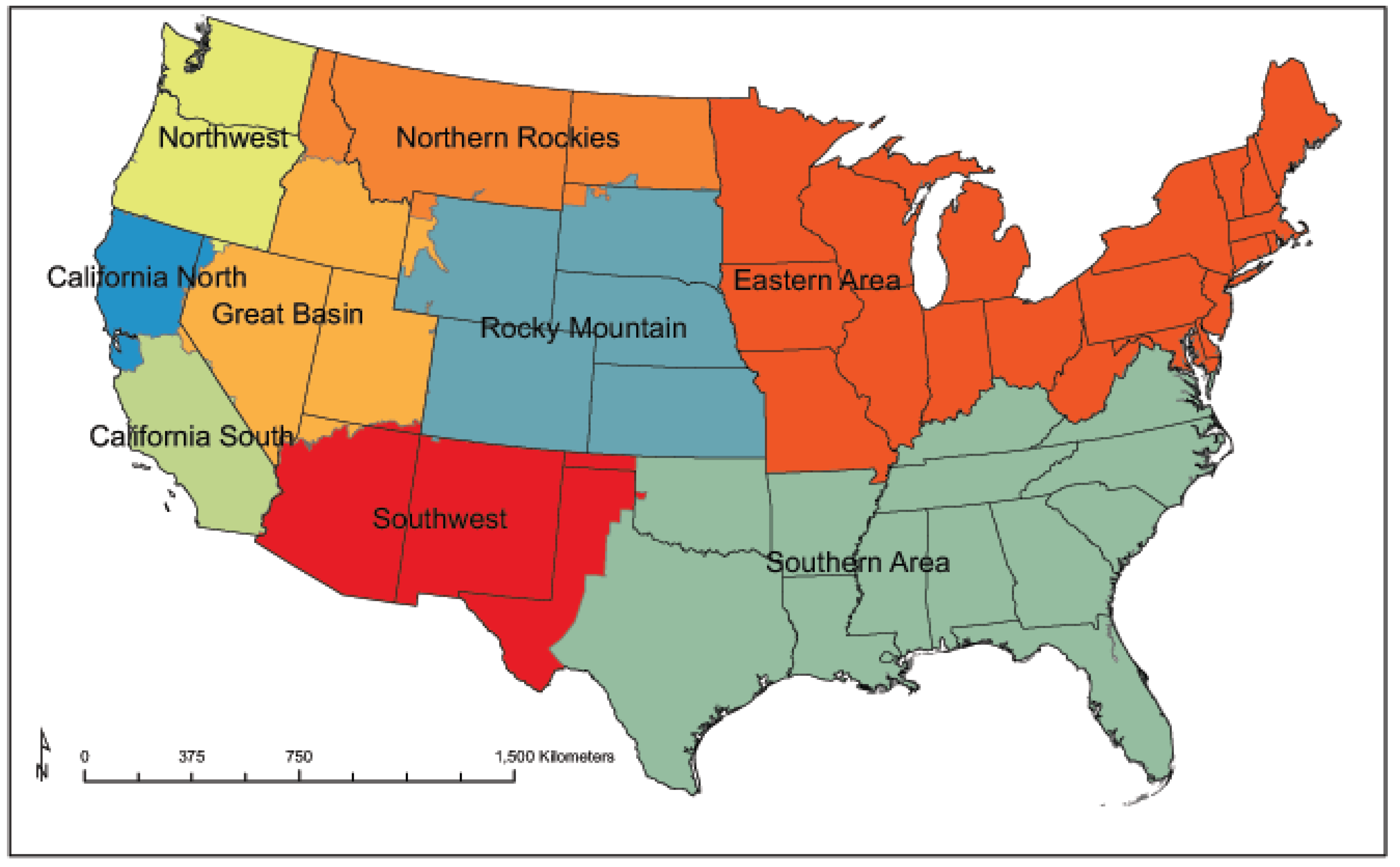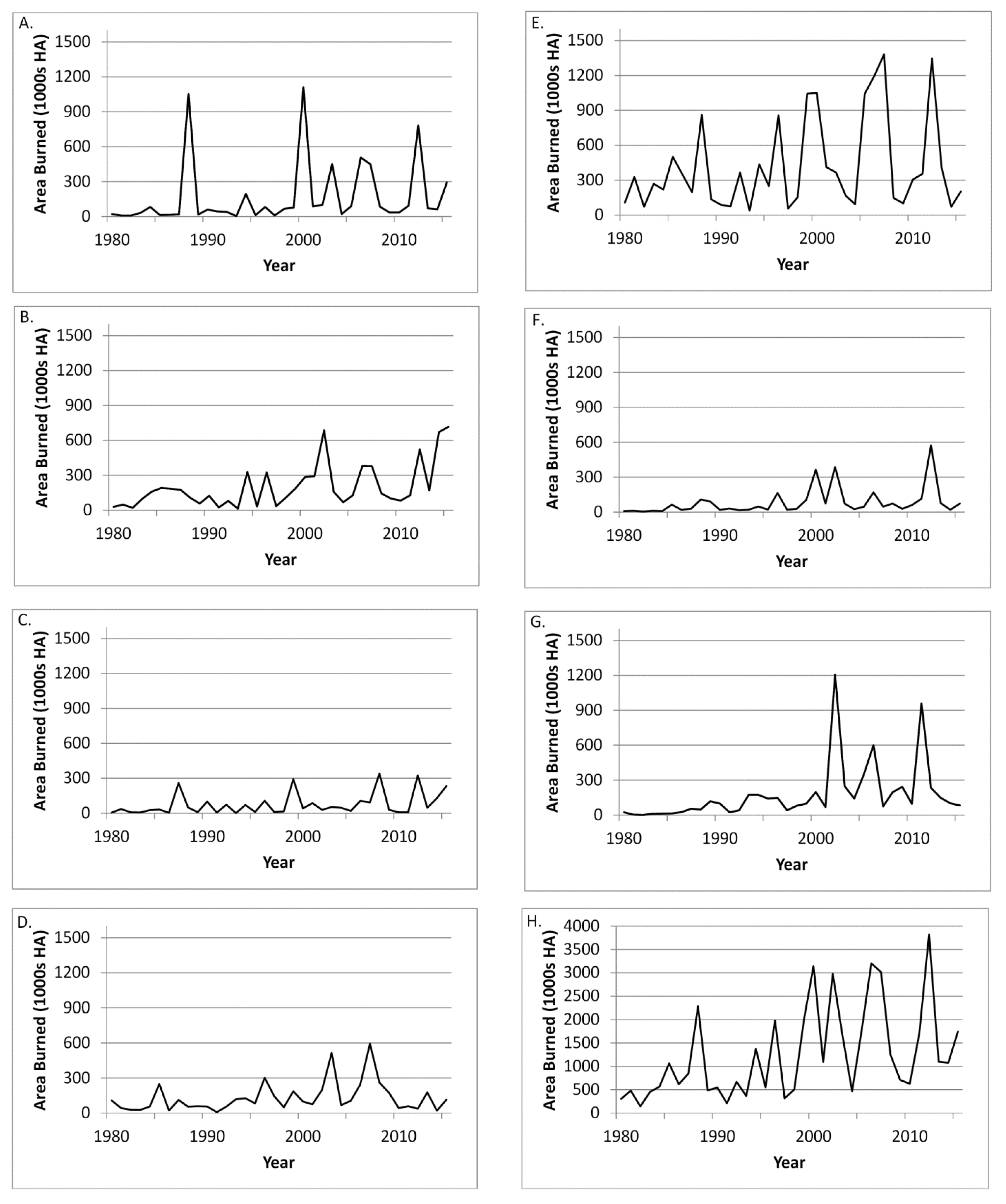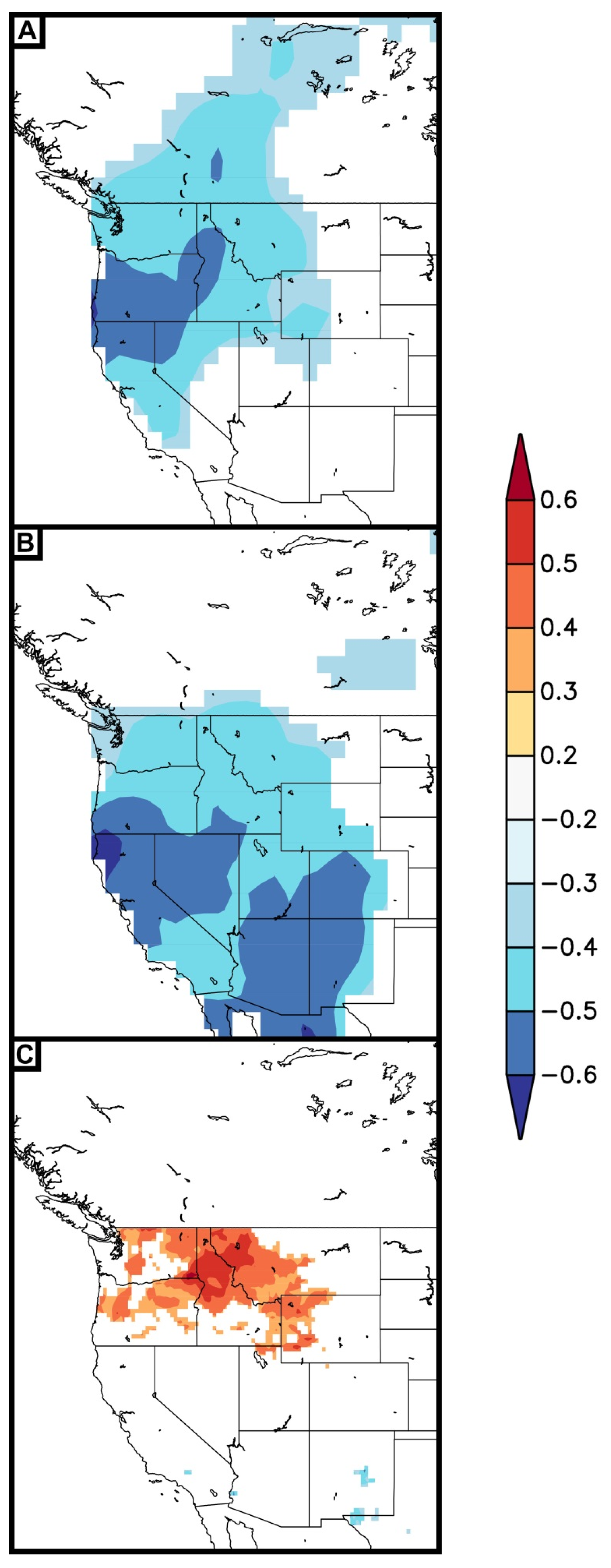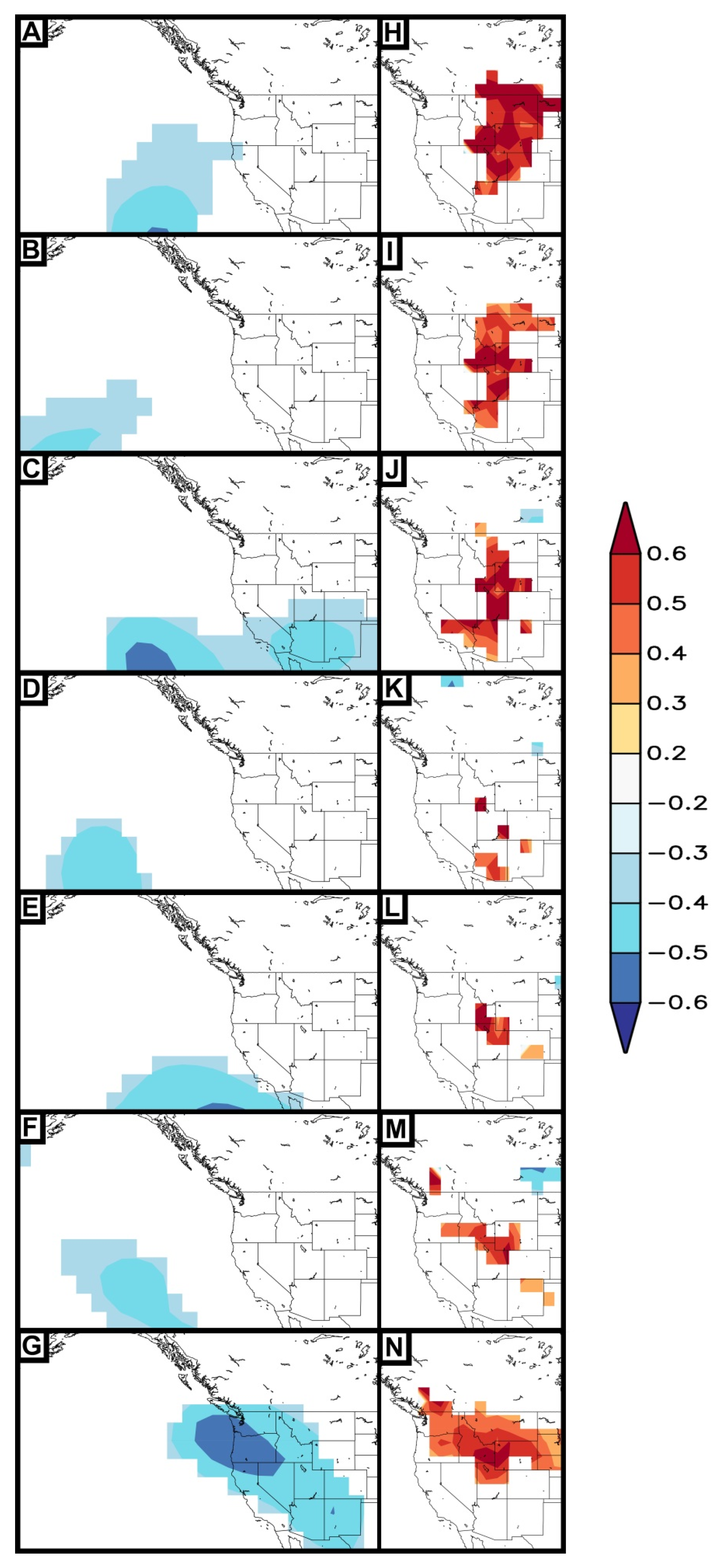Spatio-Temporal Linkages between Declining Arctic Sea-Ice Extent and Increasing Wildfire Activity in the Western United States
Abstract
:1. Introduction
2. Data and Methods
3. Results
4. Discussion
5. Conclusions
Acknowledgments
Author Contributions
Conflicts of Interest
References
- National Snow and Ice Data Center (NSIDC). Available online: http://nsidc.org/arcticseaicenews (accessed on 1 June 2017).
- Cohen, J.; Screen, J.A.; Furtado, J.C.; Barlow, M.; Whittleston, D.; Coumou, D.; Francis, J.; Dethloff, K.; Entekhabi, D.; Overland, J.; et al. Recent Arctic amplification and extreme mid-latitude weather. Nat. Geosci. 2014, 7, 627–637. [Google Scholar] [CrossRef] [Green Version]
- Polyak, L.; Alley, R.B.; Andrews, J.T.; Brigham-Grette, J.; Cronin, T.M.; Darby, D.A.; Dyke, A.S.; Fitzpatrick, J.J.; Funder, S.; Holland, M.; et al. History of sea-ice in the Arctic. Quat. Sci. Rev. 2010, 29, 1757–1778. [Google Scholar] [CrossRef]
- Lindsay, R.; Schweiger, A. Arctic sea ice thickness loss determined using subsurface, aircraft, and satellite observations. Cryosphere 2015, 9, 269–283. [Google Scholar] [CrossRef]
- Kim, B.-M.; Son, S.-W.; Min, S.-K.; Jeong, J.-H.; Kim, S.-J.; Zhang, X.; Shim, T.; Yoon, J.-H. Weakening of the stratospheric polar vortex by Arctic sea-ice loss. Nat. Commun. 2014, 5, 4646. [Google Scholar] [CrossRef] [PubMed]
- Kug, J.S.; Jeong, J.H.; Jang, Y.S.; Kim, B.M.; Folland, C.K.; Min, S.K.; Son, S.W. Two distinct influences of Arctic warming on cold winters over North America and East Asia. Nat. Geosci. 2015, 8, 759–762. [Google Scholar] [CrossRef]
- Tang, Q.; Zhang, X.; Yang, X.; Francis, J.A. Cold winter extremes in northern continents linked to Arctic sea-ice loss. Environ. Res. Lett. 2013. [Google Scholar] [CrossRef]
- Swain, D.L. A tale of two California droughts: Lessons amidst record warmth and dryness in a region of complex physical and human geography. Geophys. Res. Lett. 2015, 42, 9999–10003. [Google Scholar] [CrossRef]
- Francis, J.A.; Vavrus, S.J. Evidence for a wavier jet stream in response to rapid Arctic warming. Environ. Res. Lett. 2015, 10, 014005. [Google Scholar] [CrossRef]
- Budikova, D.; Chechi, L. Arctic sea ice and warm season North American extreme surface air temperatures. Clim. Res. 2016, 67, 15–29. [Google Scholar] [CrossRef]
- Hall, R.J.; Jones, J.M.; Hanna, E.; Scaife, A.A.; Erdélyi, R. Drivers and potential predictability of summer time North Atlantic polar front jet variability. Clim. Dynam. 2017, 48, 3869–3887. [Google Scholar] [CrossRef]
- Vihma, T. Effects of Arctic sea ice decline on weather and climate: A review. Surv. Geophys. 2014, 35, 1175–1214. [Google Scholar] [CrossRef]
- Screen, J.A. The missing Northern European winter cooling response to Arctic sea ice loss. Nat. Commun. 2017, 8, 14603. [Google Scholar] [CrossRef] [PubMed]
- Osborne, J.M.; Screen, J.A.; Collins, M. Ocean-atmosphere state dependence of the atmospheric response to Arctic sea ice loss. J. Clim. 2017, 30, 1537–1552. [Google Scholar] [CrossRef]
- Oshika, M.; Tachibana, Y.; Nakamura, T. Impact of the winter North Atlantic Oscillation (NAO) on the Western Pacific (WP) pattern in the following winter through Arctic sea ice and ENSO: Part I—Observational evidence. Clim. Dyn. 2015, 45, 1355–1366. [Google Scholar] [CrossRef]
- Coumou, D.; Lehmann, J.; Beckmann, J. The weakening summer circulation in the Northern Hemisphere mid-latitudes. Science 2015, 348, 324–327. [Google Scholar] [CrossRef] [PubMed]
- Screen, J.A.; Francis, J.A. Contribution of Sea-Ice Loss to Arctic Amplification is Regulated by Pacific Ocean Decadal Variability. 2016. Available online: https://ore.exeter.ac.uk/repository/handle/10871/20995 (accessed on 15 May 2017).
- Budikova, D.; Ford, T.W.; Ballinger, T.J. Connections between north-central United States summer hydroclimatology and Arctic sea ice variability. Int. J. Climatol. 2017. [Google Scholar] [CrossRef]
- Wu, B.; Zhang, R.; Wang, B.; D’Arrigo, R. On the association between spring Arctic sea ice concentration and Chinese summer rainfall. Geophys. Res. Lett. 2009. [Google Scholar] [CrossRef]
- Screen, J.A.; Deser, C.; Sun, L. Reduced risk of North American cold extremes due to continued Arctic sea ice loss. Bull. Am. Meteorol. Soc. 2015, 96, 1489–1503. [Google Scholar] [CrossRef]
- Westerling, A.L.; Swetnam, T.W. Interannual to decadal drought and wildfire in the western United States. EOS Trans. AGU 2003, 84, 545–555. [Google Scholar] [CrossRef]
- Westerling, A.L.; Hidalgo, H.G.; Cayan, D.R.; Swetnam, T.W. Warming and earlier spring increase western US forest wildfire activity. Science 2006, 313, 940–943. [Google Scholar] [CrossRef] [PubMed]
- Dennison, P.E.; Brewer, S.C.; Arnold, J.D.; Moritz, M.A. Large wildfire trends in the western United States, 1984–2011. Geophys. Res. Lett. 2014, 41, 2928–2933. [Google Scholar] [CrossRef]
- United States Department of Agriculture (USDA). The Rising Cost of Wildfire Operations: Effects on the Forest Service’s Non-Fire Work. 2015. Available online: http://www.google.com/url?sa=t&rct=j&q=&esrc=s&source=web&cd=1&ved=0ahUKEwio7YnF0N_NAhXKbj4KHYK_A8wQFggcMAA&url=http%3A%2F%2Fwww.fs.fed.us%2Fsites%2Fdefault%2Ffiles%2F2015-Fire-Budget-Report.pdf&usg=AFQjCNFldr8E5eakl5fxli4WIwKKYD7DQg&bvm=bv.126130881,d.cWw (accessed on 4 April 2016).
- Westerling, A.L. Increasing western US forest wildfire activity: Sensitivity to changes in the timing of spring. Phil. Trans. R. Soc. B 2016, 371. [Google Scholar] [CrossRef] [PubMed]
- Francis, J.A.; Vavrus, S.J. Evidence linking Arctic amplification to extreme weather in mid-latitudes. Geophys. Res. Lett. 2012, 39. [Google Scholar] [CrossRef]
- Federal Fire Occurrence. Available online: http://wildfire.cr.usgs.gov/firehistory/data.html (accessed on 15 January 2016).
- National Incident Management Situation Report. Available online: http://gacc.nifc.gov/nwcc/predict/intelligence.aspx (accessed 15 January 2016).
- Fetterer, F.; Knowles, K.; Meier, W.; Savoie, M. Sea-Ice Index. 2002. Available online: http://nsidc.org/data/g02135 (accessed on 15 January 2016).
- Arctic Regional Observing System. Available online: http://arctic-roos.org/observations/sea-ice-variability-in-regions (accessed on 8 June 2017).
- Kalnay, E.; Kanamitsu, M.; Kistler, R.; Collins, W.; Deaven, D.; Gandin, L.; Iredell, M.; Saha, S.; White, G.; Woollen, J.; et al. The NCEP/NCAR 40-year reanalysis project. Bull. Am. Meteorol. Soc. 1996, 77, 437–471. [Google Scholar] [CrossRef]
- Berkeley Earth. Available online: Berkeleyearth.org/ (accessed on 3 June 2017).
- PRISM. PRISM Climate Group, Oregon State University. 2004. Available online: http://prism.oregonstate.edu (accessed on 6 June 2016).
- Trouet, V.; Van Oldenborgh, G.J. KNMI Climate Explorer: A web-based research tool for high-resolution paleoclimatology. Tree Ring Res. 2013, 69, 3–13. [Google Scholar] [CrossRef]
- Sen, P.K. Estimates of the regression coefficient based on Kendall’s tau. J. Am. Stat. Assoc. 1968, 63, 1379–1389. [Google Scholar] [CrossRef]
- Wilcox, R.R.; Keselman, H.J. Modern regression methods that can substantially increase power and provide a more accurate understanding of associations. Eur. J. Pers. 2012, 26, 165–174. [Google Scholar] [CrossRef] [PubMed]
- Durbin, J.; Watson, G.S. Testing for serial correlation in least squares regression, II. Biometrika 1951, 38, 159–179. [Google Scholar] [CrossRef] [PubMed]
- Westerling, A.L.; Gershunov, A.; Brown, T.J.; Cayan, D.R.; Dettinger, M.D. Climate and wildfire in the western United States. Bull. Am. Met. Soc. 2003, 84, 595–604. [Google Scholar] [CrossRef]
- Knapp, P.A.; Soulé, P.T. Trends in midlatitude cyclone frequency and occurrence during fire season in the Northern Rockies: 1900–2004. Geophys. Res. Lett. 2007. [Google Scholar] [CrossRef]
- Jolly, W.M.; Cochrane, M.A.; Freeborn, P.H.; Holden, Z.A.; Brown, T.J.; Williamson, G.J.; Bowman, D.M. Climate-induced variations in global wildfire danger from 1979 to 2013. Nat. Commun. 2015, 6, 7537. [Google Scholar] [CrossRef] [PubMed]
- Spracklen, D.V.; Mickley, L.J.; Logan, J.A.; Hudman, R.C.; Yevich, R.; Flannigan, M.D.; Westerling, A.L. Impacts of climate change from 2000 to 2050 on wildfire activity and carbonaceous aerosol concentrations in the western United States. J. Geophys. Res. Atmos. 2009. [Google Scholar] [CrossRef]
- Francis, J.A.; Chan, W.; Leathers, D.J.; Miller, J.R.; Veron, D.E. Winter Northern Hemisphere weather patterns remember summer Arctic sea-ice extent. Geophys. Res. Lett. 2009, 36. [Google Scholar] [CrossRef]
- Screen, J.A.; Simmonds, I. Exploring links between Arctic amplification and mid-latitude weather. Geophys. Res. Lett. 2013, 40, 959–964. [Google Scholar] [CrossRef] [Green Version]
- Petrie, R.E.; Shaffrey, L.C.; Sutton, R.T. Atmospheric response in summer linked to recent Arctic sea-ice loss. Q. J. R. Meteorol. Soc. 2015, 141, 2070–2076. [Google Scholar] [CrossRef]
- Wu, B.; Zhang, R.; D'Arrigo, R.; Su, J. On the relationship between winter sea ice and summer atmospheric circulation over Eurasia. J. Clim. 2013, 26, 5523–5536. [Google Scholar] [CrossRef]
- Gedalof, Z.; Peterson, D.L.; Mantua, N.J. Atmospheric, climatic, and ecological controls on extreme wildfire years in the northwest United States. Ecol. Appl. 2005, 15, 154–174. [Google Scholar] [CrossRef]
- Hamlet, A.F.; Mote, P.W.; Clark, M.P.; Lettenmaier, D.P. Twentieth-century trends in runoff, evapotranspiration, and soil moisture in the western United States. J. Clim. 2007, 20, 1468–1486. [Google Scholar] [CrossRef]
- Swetnam, T.W.; Betancourt, J.L. Fire-southern oscillation relations in the southwestern United States. Science 1990, 249, 1017–1249. [Google Scholar] [CrossRef] [PubMed]
- Swetnam, T.W.; Betancourt, J.L. Mesoscale disturbance and ecological response to decadal climatic variability in the American southwest. J. Clim. 1998, 11, 3128–3147. [Google Scholar] [CrossRef]
- Taylor, A.H.; Beaty, R.M. Climatic influences on fire regimes in the northern Sierra Nevada Mountains, Lake Tahoe Basin, Nevada, USA. J. Biogeogr. 2005, 32, 425–438. [Google Scholar] [CrossRef]
- Hessl, A.; McKenzie, D.; Schellhaas, R. Drought and Pacific Decadal Oscillation linked to fire occurrence in the Inland Pacific Northwest. Ecol. Appl. 2004, 14, 425–442. [Google Scholar] [CrossRef]
- Heyerdahl, E.K.; Brubaker, L.B.; Agee, J.K. Annual and decadal climate forcing of historical fire regimes in the interior Pacific Northwest, USA. Holocene 2002, 12, 597–604. [Google Scholar] [CrossRef]
- Heyerdahl, E.K.; McKenzie, D.; Daniels, L.D.; Hessl, A.E.; Littell, J.S.; Mantua, N.J. Climate drivers of regionally synchronous fires in the inland northwest (1651–1900). Int. J. Wildland Fire 2008, 17, 40–49. [Google Scholar] [CrossRef]
- Schoennagel, T.; Veblen, T.T.; Romme, W.H.; Sibold, J.S.; Cook, E.R. ENSO and PDO variability affect drought-induced fire occurrence in Rocky Mountain subalpine forests. Ecol. Appl. 2005, 15, 2000–2014. [Google Scholar] [CrossRef]
- Gedalof, Z. Climate and spatial patterns of wildfire in North America. In The Landscape Ecology of Fire; Springer: Dordrecht, The Netherlands, 2011; pp. 89–115. [Google Scholar]
- Morgan, P.; Heyerdahl, E.K.; Gibson, C.E. Multi-season climate synchronized forest fires throughout the 20th century, northern Rockies, USA. Ecology 2008, 89, 717–728. [Google Scholar] [CrossRef] [PubMed]
- Kitzberger, T.; Brown, P.M.; Heyerdahl, E.K.; Swetnam, T.W.; Veblen, T.T. Contingent Pacific–Atlantic Ocean influence on multicentury wildfire synchrony over western North America. Proc. Natl. Acad. Sci. USA 2007, 104, 543–548. [Google Scholar] [CrossRef] [PubMed]
- Fauria, M.M.; Johnson, E.A. Climate and wildfires in the North American boreal forest. Philos. Trans. R. Soc. Lond. B Biol. Sci. 2008, 363, 2315–2327. [Google Scholar] [CrossRef] [PubMed]
- Barbero, R.; Abatzoglou, J.T.; Brown, T.J. Seasonal reversal of the influence of El Niño–Southern Oscillation on very large wildfire occurrence in the interior northwestern United States. Geophys. Res. Lett. 2015, 42, 3538–3545. [Google Scholar] [CrossRef]
- West, A.M.; Kumar, S.; Jarnevich, C.S. Regional modeling of large wildfires under current and potential future climates in Colorado and Wyoming, USA. Clim. Change 2016, 134, 565–577. [Google Scholar] [CrossRef]
- Balmaseda, M.A.; Ferranti, L.; Molteni, F.; Palmer, T.N. Impact of 2007 and 2008 Arctic ice anomalies on the atmospheric circulation: Implications for long-range predictions. Q. J. R. Meteorol. Soc. 2010, 136, 1655–1664. [Google Scholar] [CrossRef]
- Marlon, J.R.; Bartlein, P.J.; Gavin, D.G.; Long, C.J.; Anderson, R.S.; Briles, C.E.; Brown, K.J.; Colombaroli, D.; Hallett, D.J.; Power, M.J.; et al. Long-term perspective on wildfires in the western USA. Proc. Natl. Acad. Sci. USA 2012, 109, E535–E543. [Google Scholar] [CrossRef] [PubMed]
- Girardin, M.P.; Ali, A.A.; Carcaillet, C.; Mudelsee, M.; Drobyshev, I.; Hely, C.; Bergeron, Y. Heterogeneous response of circumboreal wildfire risk to climate change since the early 1900s. Global Change Biol. 2009, 15, 2751–2769. [Google Scholar] [CrossRef]
- Parisien, M.A.; Snetsinger, S.; Greenberg, J.A.; Nelson, C.R.; Schoennagel, T.; Dobrowski, S.Z.; Moritz, M.A. Spatial variability in wildfire probability across the western United States. Int. J. Wildland Fire, 2013, 21, 313–327. [Google Scholar] [CrossRef]
- Mallek, C.; Safford, H.; Viers, J.; Miller, J. Modern departures in fire severity and area vary by forest type, Sierra Nevada and southern Cascades, California, USA. Ecosphere 2013, 4, 1–28. [Google Scholar] [CrossRef]
- Schoennagel, T.; Veblen, T.T.; Romme, W.H. The interaction of fire, fuels, and climate across Rocky Mountain forests. Bioscience 2004, 54, 661–676. [Google Scholar] [CrossRef]
- Screen, J.A. Far-flung effects of Arctic warming. Nat. Geosci. 2017, 10, 253–254. [Google Scholar] [CrossRef]
- Overland, J.; Francis, J.A.; Hall, R.; Hanna, E.; Kim, S.-J.; Vihma, T. The melting Arctic and midlatitude weather patterns: Are they connected? J. Clim. 2015, 28, 7917–7932. [Google Scholar] [CrossRef]
- Liu, Y.; Goodrick, S.L.; Stanturf, J.A. Future US wildfire potential trends projected using a dynamically downscaled climate change scenario. For. Ecol. Manag. 2013, 294, 120–135. [Google Scholar] [CrossRef]




| Region | Mann–Kendall Trend Test Significance | Sen’s Slope Estimator Q (Hectares/Year) |
|---|---|---|
| Northern Rockies | ** | 2787.4 |
| Northwest | ** | 5860.7 |
| Northern California | * | 1711 |
| Southern California | + | 2266.8 |
| Great Basin | NS | 3880.1 |
| Rocky Mountain | ** | 1849.3 |
| Southwest | ** | 5685.8 |
| Combined | ** | 36043 |
| Region and Month | December Lag | January | February | March | April | May | June | July | August | September |
|---|---|---|---|---|---|---|---|---|---|---|
| Northern Rockies | −0.593 ** | −0.683 ** | −0.555 ** | −0.468 ** | −0.443 ** | −0.388 * | −0.506 * * | −0.457 ** | −0.413 * | −0.408 * |
| Northwest | −0.527 ** | −0.506 ** | −0.411 * | −0.420 ** | −0.384 * | −0.299 * | −0.382 * | −0.404 * | −0.365 * | −0.344 * |
| Northern California | −0.419 * | −0.397 * | −0.338 | −0.371 * | −0.326 | −0.215 | −0.283 | −0.331 * | −0.326 | −0.286 |
| Southern California | −0.324 | −0.254 | −0.221 | −0.306 | −0.362 * | −0.171 | −0.148 | −0.274 | −0.273 | −0.223 |
| Great Basin | −0.338 | −0.391 * | −0.305 | −0.288 * | −0.163 | −0.104 | −0.190 | −0.180 | −0.152 | −0.105 |
| Rocky Mountain | −0.568 ** | −0.582 ** | −0.513 ** | −0.508 ** | −0.453 ** | −0.403 * | −0.444 ** | −0.493 ** | −0.443 ** | −0.441 ** |
| Southwest | −0.548 ** | −0.573 ** | −0.611 ** | −0.636 ** | −0.645 ** | −0.611 ** | −0.674 ** | −0.620 ** | −0.626 ** | −0.607 ** |
| Combined | −0.652 ** | −0.660 ** | −0.562 ** | −0.539 ** | −0.464 ** | −0.392 * | −0.505 ** | −0.512 ** | −0.479 ** | −0.439 ** |
| Region and Month | December Lag | January | February | March | April | May | June | July | August | September |
|---|---|---|---|---|---|---|---|---|---|---|
| Northern Rockies | −0.533 ** | −0.503 ** | −0.580 ** | −0.541 ** | −0.465 ** | −0.386 * | −0.457 ** | −0.456 ** | −0.474 ** | −0.395 * |
| Baffin | Greenland | Greenland | Greenland | Barents | Barents | E. Siberian | Barents | Barents | E. Siberian | |
| Northwest | −0.458 ** | −0.530 ** | −0.528 ** | −0.523 ** | −0.388 * | -- | −0.422 * | −0.486 ** | −0.506 ** | −0.405 * |
| E. Siberian | Greenland | Greenland | Greenland | E. Siberian | -- | E. Siberian | Barents | Barents | Barents | |
| Northern California | −0.418 * | -- | −0.341 * | −0.477 ** | -- | -- | -- | -- | -- | -- |
| Barents | -- | Greenland | Greenland | -- | -- | -- | -- | -- | -- | |
| Southern California | −0.532 ** | -- | -- | -- | -- | -- | -- | −0.337 * | -- | -- |
| Greenland | -- | -- | -- | -- | -- | Greenland | -- | -- | ||
| Great Basin | −0.457 ** | −0.399 * | -- | −0.375 * | −0.480 ** | −0.346 * | -- | −0.413 * | −0.521 ** | −0.489 ** |
| Baffin | Greenland | -- | Baffin | Baffin | Baffin | -- | Barents | Barents | Barents | |
| Rocky Mountain | −0.560 ** | −0.387* | −0.363 * | −0.398 * | −0.386 * | −0.352 * | −0.466 ** | −0.491 ** | −0.432 ** | −0.416 * |
| Baffin | E. Siberian | Greenland | Greenland | Baffin | Baffin | Baffin | Barents | Barents | E. Siberian | |
| Southwest | −0.512 ** | −0.479 ** | −0.531 ** | −0.565 ** | −0.586 ** | -458 ** | −0.589 ** | −0.572 ** | −0.578 ** | −0.567 ** |
| E. Siberian | E. Siberian | Greenland | E. Siberian | E. Siberian | Greenland | Baffin | E. Siberian | E. Siberian | E. Siberian | |
| Combined | −0.613 ** | −0.539 ** | −0.558 ** | −0.567 ** | −0.466 ** | −0.366 * | −0.467 ** | −0.541 ** | −0.490 ** | −0.444 ** |
| E. Siberian | Greenland | Greenland | Greenland | Barents | Barents | Baffin | Barents | Barents | E. Siberian |
© 2017 by the authors. Licensee MDPI, Basel, Switzerland. This article is an open access article distributed under the terms and conditions of the Creative Commons Attribution (CC BY) license (http://creativecommons.org/licenses/by/4.0/).
Share and Cite
Knapp, P.A.; Soulé, P.T. Spatio-Temporal Linkages between Declining Arctic Sea-Ice Extent and Increasing Wildfire Activity in the Western United States. Forests 2017, 8, 313. https://doi.org/10.3390/f8090313
Knapp PA, Soulé PT. Spatio-Temporal Linkages between Declining Arctic Sea-Ice Extent and Increasing Wildfire Activity in the Western United States. Forests. 2017; 8(9):313. https://doi.org/10.3390/f8090313
Chicago/Turabian StyleKnapp, Paul A., and Peter T. Soulé. 2017. "Spatio-Temporal Linkages between Declining Arctic Sea-Ice Extent and Increasing Wildfire Activity in the Western United States" Forests 8, no. 9: 313. https://doi.org/10.3390/f8090313




